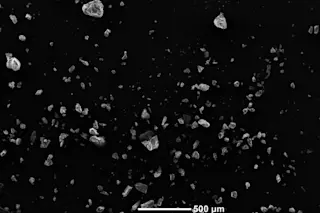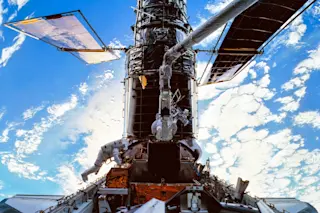Columbia and the Year of Flight
‘Roger, uh–’radioed flight commander Rick D. Husband, 45, as he acknowledged news from Mission Control that there were wonky tire-pressure readings from sensors on the left wing of the space shuttle Columbia.
There were no further voice communications from Columbia.
It happened in the centennial year of the first manned flight. Near Kitty Hawk, North Carolina, in 1903, the Wright brothers managed to urge their motorized kite some 120 feet into a gust off the sea that might have elevated a barn door. A hundred years later Columbia, with its crew of seven, flew 200,000 feet above Texas, meeting the atmosphere at 12,500 miles per hour and on schedule for a touchdown at the Kennedy Space Center in Florida, 16 minutes later. Colonel Husband’s wife and two children waited there to welcome him back to Earth.
That was at 9 a.m. EST, on Saturday, February 1.
On the ground in Texas, the general public realized as soon as the flight engineers did that something was wrong. In a little house in the woods outside Nacogdoches, Donna Lipschutz was vacuuming when the sky started falling. “The first thing I thought was that my washing machine was off balance. We were standing around saying, ‘What could that be?’”
Then they started finding the pieces: in the watermelon patch behind Elmo’s store, in the drive-through of the Commercial Bank in downtown Nacogdoches, in ditches along roadsides among the beer cartons, truck mud flaps, and Styrofoam Sonic Drive-in containers. Many of the fragments hit hard and skidded, kicking up red Texas dirt. Incredibly, no one on the ground was hit. The momentum of the pieces with the greatest mass carried them farthest from the point of breakup, to eastern Texas and the Louisiana border, relatively unpopulated parts of the nation.
There were shards of steel and, worse, helmets and body parts. Following a track of lopped-off pine branches, one man found a piece of a computer board; another found a container with worms that had been part of an experiment, the only organisms aboard the shuttle that made it back to Earth alive. Some 25,000 people, from deer hunters on horseback to National Guardsmen, carved the countryside into a grid, wading through briars and swamps to collect more than 84,000 pieces of debris, about a third of the shuttle. NASA workers, the FBI, FEMA, and the EPA rushed into the area, coordinating with volunteers to mark the finds with yellow plastic tape, and then testing the pieces for toxic volatile organic compounds. “Varmints and vultures” were vying for the remains, figured Narlon Chambless. He measured a spear of metal in his front yard that had pierced the earth. Turkey buzzards circled above. “It’s sad for their families,” he said. “But they knew the risks when they got up in that thing.”
From the very first shuttle flight, flown by Columbia in 1981, NASA calculated the odds of catastrophic failure during launch to be 1 in 78. Then, in 1986, the Challenger exploded just after liftoff with a crew of seven on board. There had been 25 shuttle flights: 1 in 25. NASA then set the goal of improving safety and reducing those odds to 1 in 1,000 by the year 2005. In the wake of 40 percent budget and staffing cuts, the agency struggled to keep the odds to 1 in 250 when Columbia made her 28th and last voyage. Two shuttles down in 113 flights: 1 in 56.5. Dark humorists suggested that NASA stood for “Need Another Seven Astronauts.”
Challenger had plunged into the ocean, which covers three-quarters of Earth’s surface. This time, to reconstruct the cause of the breakup, NASA got to pick up the pieces spread over 2,000 square miles from Littlefield, Texas, to Fort Polk, Louisiana. Under the aegis of the Columbia Accident Investigation Board, a staff of 120 aided by 400 engineers began the task of reassembling fragments and analyzing data at Cape Canaveral. In the end, after an investigation that took seven months and cost $400 million, the board issued a 248-page report fingering the initial suspect: a piece of foam insulation that had struck the edge of the left wing, damaging the hide. When the spacecraft hit the atmosphere, the injury melted into a hole, which allowed superheated air to flow toward the wheel well, melting the aluminum trusses that supported the wing.
NASA had known since before the shuttle ever flew that the thermal protection system, a combination of heat-resistant tiles and reinforced carbon-carbon panels, was a weak point. At first, NASA assumed that one of the 24,000 tiles—resilient enough to withstand 2,700-degree-Fahrenheit temperatures and yet fragile enough to be punctured with a fingernail—had been damaged. But instead it became apparent that the insulation had actually hit the superstrong panels on the wing. The leading edge of each wing is protected by 22 such panels, made of graphite- and resin-impregnated rayon, heated and treated until it becomes a carbon-on-carbon armor.
The Columbia, the oldest ship in the fleet, was flying with mostly original panels, including those that were probably damaged by the foam. The Columbia Accident Investigation Board found that the administration’s “current inspection techniques are not adequate to assess structural integrity” of these protective panels. NASA had been well aware that even one square-inch perforation in the wrong place in the Columbia’s protective sheath, including the panels, meant death.
The accident board learned that engineers had, in fact, suspected damage to Columbia’s thermal protection system but that higher-ups had brushed off their concerns. So the board reserved its severest criticism for the agency’s bureaucracy, charging that NASA suffers from a “broken safety culture” and warning that “unless the technical, organizational, and cultural recommendations made in this report are implemented, little will have been accomplished to lessen the chance that another accident will follow.”
The next accident involving a manned spacecraft could be far worse: NASA is pushing forward a $1 billion program that includes development of a nuclear-powered rocket.
Pushing the limits of human exploration has always been risky, yet after each space tragedy, presidents and pundits conclude that the program must go on. Even accident board member John M. Logsdon, director of the Space Policy Institute at George Washington University, said, “None of us has come to the conclusion that it is not worth the risk and not worth the money.”
Right now, two dozen teams in five countries are competing for the X Prize, trying to develop spacecraft that will launch private exploration. Right now, two people are manning the International Space Station, in orbit 225 miles up. And right now would-be adventurers are longingly eyeing the planet Mars. The dream of flight and a yearning to explore have been embedded in human nature since long before the Wright brothers first took wing a hundred years ago. This year, seven dreamers died. They were still bravely with the program to the last word: “Roger.”














